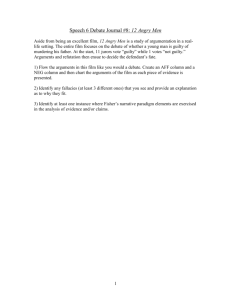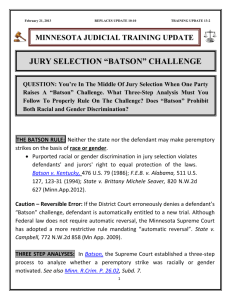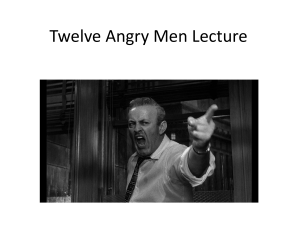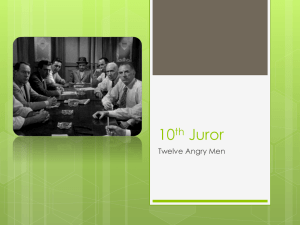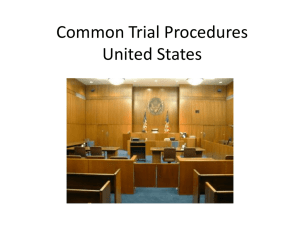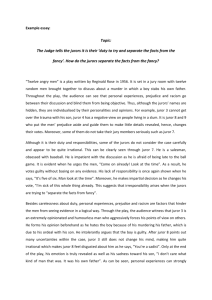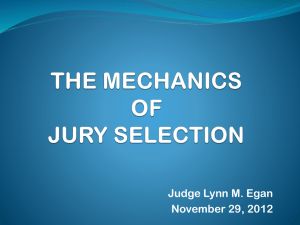State v
advertisement
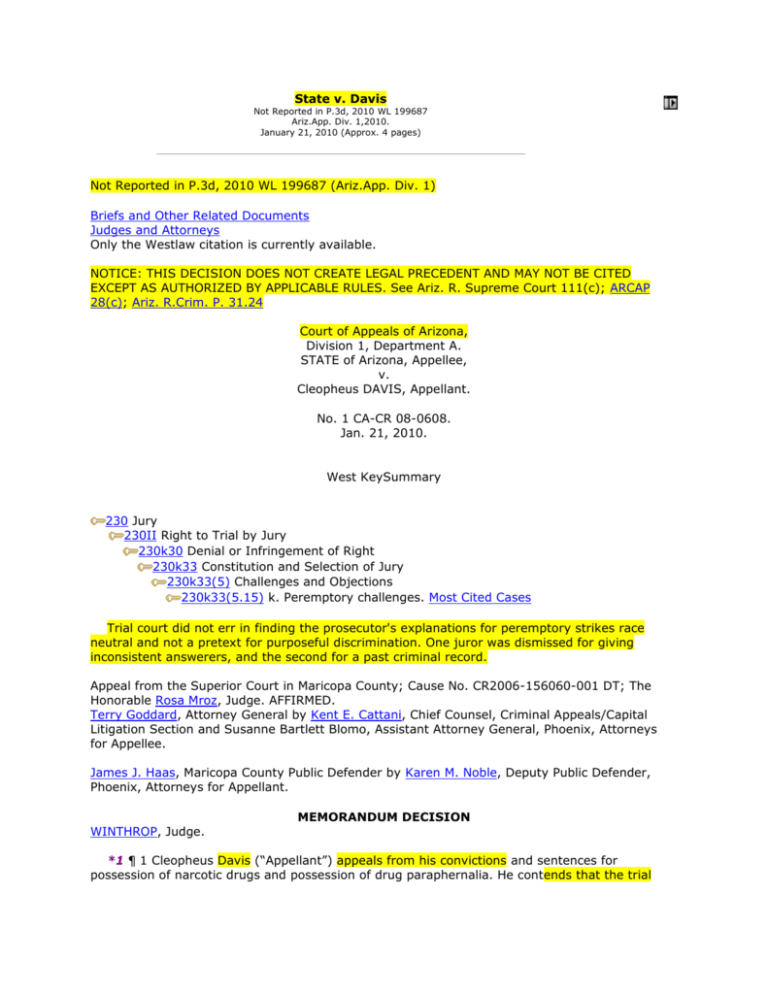
State v. Davis Not Reported in P.3d, 2010 WL 199687 Ariz.App. Div. 1,2010. January 21, 2010 (Approx. 4 pages) Not Reported in P.3d, 2010 WL 199687 (Ariz.App. Div. 1) Briefs and Other Related Documents Judges and Attorneys Only the Westlaw citation is currently available. NOTICE: THIS DECISION DOES NOT CREATE LEGAL PRECEDENT AND MAY NOT BE CITED EXCEPT AS AUTHORIZED BY APPLICABLE RULES. See Ariz. R. Supreme Court 111(c); ARCAP 28(c); Ariz. R.Crim. P. 31.24 Court of Appeals of Arizona, Division 1, Department A. STATE of Arizona, Appellee, v. Cleopheus DAVIS, Appellant. No. 1 CA-CR 08-0608. Jan. 21, 2010. West KeySummary 230 Jury 230II Right to Trial by Jury 230k30 Denial or Infringement of Right 230k33 Constitution and Selection of Jury 230k33(5) Challenges and Objections 230k33(5.15) k. Peremptory challenges. Most Cited Cases Trial court did not err in finding the prosecutor's explanations for peremptory strikes race neutral and not a pretext for purposeful discrimination. One juror was dismissed for giving inconsistent answerers, and the second for a past criminal record. Appeal from the Superior Court in Maricopa County; Cause No. CR2006-156060-001 DT; The Honorable Rosa Mroz, Judge. AFFIRMED. Terry Goddard, Attorney General by Kent E. Cattani, Chief Counsel, Criminal Appeals/Capital Litigation Section and Susanne Bartlett Blomo, Assistant Attorney General, Phoenix, Attorneys for Appellee. James J. Haas, Maricopa County Public Defender by Karen M. Noble, Deputy Public Defender, Phoenix, Attorneys for Appellant. MEMORANDUM DECISION WINTHROP, Judge. *1 ¶ 1 Cleopheus Davis (“Appellant”) appeals from his convictions and sentences for possession of narcotic drugs and possession of drug paraphernalia. He contends that the trial court erred in denying his Batson following reasons, we affirm. FN1 challenge to two of the State's peremptory strikes. For the FN1. See Batson v. Kentucky, 476 U.S. 79, 106 S.Ct. 1712, 90 L.Ed.2d 69 (1986). FACTS AND PROCEDURAL HISTORYFN2 FN2. We view the facts in the light most favorable to sustaining the verdict, and we resolve all reasonable inferences against Appellant. State v. Greene, 192 Ariz. 431, 436, ¶ 12, 967 P.2d 106, 111 (1998). ¶ 2 On April 16, 2007, Appellant was charged by information with one count of possession or use of narcotic drugs, a class 4 felony, and one count of possession of drug paraphernalia, a class 6 felony. See Ariz.Rev.Stat. (“A.R.S.”) §§ 13-3408 (Supp.2009),FN3 13-3415 (2001). These charges stemmed from events occurring on June 2, 2006. FN3. We cite the current version of the statute because no revisions material to our analysis have since occurred. ¶ 3 At trial, the jury found Appellant guilty of both counts, and the court sentenced Appellant to concurrent mitigated terms of eight and three years on the two counts, respectively. ¶ 4 We have jurisdiction over Appellant's timely appeal. See Ariz. Const. art. 6, § 9; A.R.S. §§ 12-120.21(A)(1) (2003), 13-4031 (2001), 13-4033(A) (Supp.2009). ANALYSIS ¶ 5 Appellant argues that the trial court erred in denying his Batson challenge to the State's peremptory strikes of prospective juror 33 (“Juror 33”) and prospective juror 40 (“Juror 40”), apparently the only identified African American venire persons.FN4 FN4. The record does not identify the race of other persons on the pan el. Although not relevant to our analysis, we also note that Appellant is African American. ¶ 6 We will not reverse a trial court's denial of a Batson challenge unless clearly erroneous. State v. Ne well, 212 Ariz. 389, 400, ¶ 52, 132 P.3d 833, 844 (2006). First, a party making a Batson challenge must make a prima facie showing that the strike was based on race. State v. Gay, 214 Ariz. 214, 220, ¶ 17, 150 P.3d 787, 793 (App.2007). The party exercising the strike must then provide a race-neutral explanation for the strike, which must be more than a mere denial of improper motive, but need not be persuasive or plausible. Id. Once a race-neutral reason is given, the challenging party must persuade the court that the proffered explanation is a pretext for discrimination. Id. We give great deference to the trial court's determination whether a race-neutral explanation is pretextual because that court is in the best position to evaluate the prosecutor's sincerity and credibility, as well as the venire pan el's behavior. See State v. Canez, 202 Ariz. 133, 147, ¶ 28, 42 P.3d 564, 578 (2002); Gay, 214 Ariz. at 220-21, ¶¶ 17, 19, 150 P.3d at 793-94. ¶ 7 In this case, at the conclusion of jury selection, defense counsel raised a Batson challenge to the prosecutor's use of peremptory strikes for Juror 33 and Juror 40. Although the trial court did not specifically find that defense counsel had made a prima facie showing that the strikes were based on race, the court asked the prosecutor to articulate race-neutral reasons for striking Juror 33 and Juror 40. In so doing, the court implicitly found that defense counsel had made a prima facie showing under the first step of the Batson analysis. See Gay, 214 Ariz. at 220-21 n. 4, ¶ 18, 150 P.3d at 793-94 n. 4. *2 ¶ 8 During jury selection, Juror 33, an unmarried father who had never served on a jury before, described himself as semi-retired and working in the logistics operation for Micro Electronic Center. When the trial court asked, “Have you or a close relative or friend of yours ever been arrested, charged or convicted of any crime other than a minor traffic offense?”, Juror 33 reported that his youngest brother had been in prison three times, most recently for a drug crime. The following exchange took place: THE COURT: Do you think you can set aside what happened to your brother and judge this case fairly and impartially? [JUROR 33]: I really don't know, to tell you the truth. THE COURT: Okay. If you were sitting in [Appellant's] position, would you want someone such as yourself to be sitting in judgment? [JUROR 33]: I think I would be okay with it. THE COURT: Okay. If you were sitting where the prosecutors are sitting, would you want someone such as yourself to be sitting in judgment? [JUROR 33]: If I was sitting at Mr.THE COURT: If you were sitting over here, you were with the prosecution now. [JUROR 33]: I don't think it would be a problem. THE COURT: You don't think you could be impartial or did you think it would be a problem? [JUROR 33]: Again, it's a tough one to call, really, whether I could be able to stand in judgment or not. THE COURT: Okay. All right. I just want to make sure I'm understanding you. Because when I asked you the first time if you were sitting over where [ Appellant] is sitting, the defense, would you want someone such as yourself to be sitting in judgment? [JUROR 33]: Yes. THE COURT: You would? So now we're switching to the other side. I want to make sure I understand what your answers were. If you were on the prosecution's side, you're the prosecutor, would you want someone such as yourself to be sitting in judgment? [JUROR 33]: Yes. When challenged, the prosecutor cited Juror 33's inconsistent statements and initial “reluctance to be more sympathetic for the prosecution.” Juror 40, who had never sat on a jury, described herself as unmarried, without children, and working in the appraisals department of a local bank. In response to the same question as Juror 33, above, Juror 40 reported that she had been arrested for domestic violence in 2006, but that the situation had been resolved and “[e]verything was dropped.” When asked, “Would you be able to set aside what happened to [you] and judge this case fair and impartial [sic]?”, Juror 40 said, “Yes.” ¶ 9 When explaining her strike of Juror 40, the prosecutor cited the domestic violence arrest coupled with what the prosecutor asserted was a noticeable smirk “that was personally observed not only by myself but other people in the courtroom.” Defense counsel said that she had not observed a smirk, but did not reject the possibility that Juror 40 may have smirked when she said, “That could be for other reasons if she had a smirk on her face.” *3 ¶ 10 The trial court found that the State's reasons for striking Juror 33 and Juror 40 were race-neutral and denied defense counsel's Batson challenge. We conclude that the trial court did not err in finding the prosecutor's explanations raceneutral and not a pretext for purposeful discrimination. ¶ 11 With respect to Juror 33, the State's concerns about inconsistent statements may qualify as reasonable race-neutral explanations for a strike, unless the plausibility of the explanation is undercut by other evidence of pretext. See Miller-El v. Dretke, 545 U.S. 231, 248, 125 S.Ct. 2317, 162 L.Ed.2d 196 (2005); Newell, 212 Ariz. at 401-02, ¶ 58, 132 P.3d at 845-46. In addition to Juror 33's inconsistent statements, the prosecutor also perceived a “reluctance to be more sympathetic [to] the prosecution” rather than the defense. “As long as it is not based on race, perceived sympathy on the part of a prospective juror toward a defendant is a legitimate basis for a peremptory strike.” State v. Hernandez, 170 Ariz. 301, 305-06, 823 P.2d 1309, 131314 (App.1991) (concerning prospective juror who might be overly sympathetic to youthfullooking defendant). ¶ 12 Appellant argues that the trial court inaccurately recalled Juror 33 saying “[I] really don't know or I don't know, something to that effect” when asked whether he could be fair and impartial. As noted above, however, Juror 33 said, “I really don't know, to tell you the truth” when asked if he could judge the case fairly and impartially. Furthermore, during the same exchange, Juror 33 said, “[I]t's a tough one to call ... whether I could be able to stand in judgment or not [, ]” when asked if he could be impartial. A prosecutor's explanation for exercising a peremptory strike based upon concerns about a juror's ability to be fair and impartial “need not rise to the level justifying exercise of a challenge for cause.” Batson, 476 U.S. at 97; see State v. Purcell, 199 Ariz. 319, 329, ¶ 33, 18 P.3d 113, 123 (App.2001). Thus, the trial court did not err in finding the State's reason for striking Juror 33 to be race-neutral. ¶ 13 Regarding Juror 40, mention of her prior arrest for domestic violence constitutes a raceneutral reason for exercising a peremptory strike. See Canez, 202 Ariz. at 146, ¶ 26, 42 P.3d at 577 (mentioning “criminal history” as race-neutral reason for exercising peremptory strike). Additionally, the prosecution explained to the court, “when you asked whether she could be fair and impartial, she sat down with a smirk on her face [.]” “[A]lthough it is inappropriate to simply allude to ‘feelings' about a juror, it is appropriate to consider factors which reflect attitude.” Hernandez, 170 Ariz. at 305, 823 P.2d at 1313 (citations omitted). A “smirk” could reflect the potential juror's attitude about the proceedings. Combined with Juror 40's prior arrest, the trial court did not err in finding the prosecutor's justifications to be race-neutral. *4 ¶ 14 Citing Miller-El v. Dretke, 545 U.S. 231, 125 S.Ct. 2317, 162 L.Ed.2d 196, Appellant argues that the prosecutor should have further questioned the two jurors if she was concerned about either potential juror's impartiality or attitude.FN5 While this is the preferable course of action, the Miller-El court did not hold that follow-up questions are a requirement before a prosecutor exercises a peremptory strike. Moreover, the prosecutor's concern about Juror 40's attitude-tipped off by her “smirk”-had nothing to do with her answers and therefore was something follow-up questions might not clarify. FN5. In Miller-El, the Supreme Court of the United States found a prosecutor's explanation for exercising a strike on a potential juror suspicious in part because the prosecutor did not ask follow-up questions on the matter about which he was purportedly concerned. 545 U.S. at 246. ¶ 15 Appellant further argues that the State's failure to strike non-African American jurors with the same characteristics as Juror 33 and Juror 40 is proof of the speculative, improper nature of the State's strikes. Specifically, Appellant notes that Juror 43, who was seated as a juror, was like Juror 40 in that they both worked in the banking industry. The State's reason for striking Juror 40, however, had nothing to do with her work in the banking industry. Moreover, unlike Juror 40, Juror 43 had never been arrested. The State's failure to strike Juror 43 is not strong evidence that the prosecutor's explanation for striking Juror 40 was pretextual. ¶ 16 Citing State v. Cruz, 175 Ariz. 395, 399, 857 P.2d 1249, 1253 (1993), FN6 Appellant asserts that the trial court erred in failing to further scrutinize the State's “subjective” reasons for striking Juror 33 and Juror 40. First, we do not believe that inconsistent statements, Juror 33's brother's drug arrests, and Juror 40's own arrest, constitute subjective observations or speculation. The State correctly notes, however, that, even if its reasons were subjective, the “objective verification” requirement announced in Cruz has been overruled. See Canez, 202 Ariz. at 146, ¶ 26, 42 P.3d at 577. FN6. In Cruz, the prosecution struck a prospective juror for being “weak” and appearing easily led-subjective reasons. 175 Ariz. at 399, 857 P.2d at 1253. The court said that when the prosecution's reason for striking a juror is “facially neutral, but wholly subjective, ... it must be coupled with some form of objective verification before it can overcome the prima facie showing of discrimination.” Id. (citations omitted). ¶ 17 For the foregoing reasons, we conclude that Appellant has failed to meet his burden of proving purposeful discrimination. See State v. Roque, 213 Ariz. 193, 204, ¶ 15, 141 P.3d 368, 379 (2006). The prosecutor offered permissible, race-neutral explanations for striking Juror 33 and Juror 40, and Appellant has not shown the clear error necessary to disturb the trial court's denial of his Batson challenge. CONCLUSION ¶ 18 We affirm Appellant's convictions and sentences. CONCURRING: MAURICE PORTLEY, Presiding Judge, and MARGARET H. DOWNIE, Judge. Ariz.App. Div. 1,2010. State v. Davis Not Reported in P.3d, 2010 WL 199687 (Ariz.App. Div. 1) Briefs and Other Related Documents (Back to top) • 2009 WL 4026578 (Appellate Brief) Appellant's Reply Brief (Oct. 21, 2009) Original Image of this Document (PDF) • 2009 WL 4026577 (Appellate Brief) Appellee's Answering Brief (Sep. 25, 2009) Original Image of this Document (PDF) • 2009 WL 1700773 (Appellate Brief) Appellant's Opening Brief (May 6, 2009) Original Image of this Document (PDF) Judges and Attorneys (Back to top) Judges | Attorneys Judges Downie, Hon. Margaret H. State of Arizona Court of Appeals, 1st Division Arizona Litigation History Report | Judicial Reversal Report | Judicial Expert Challenge Report | Profiler Mroz, Hon. Rosa P. State of Arizona Superior Court, Maricopa County Arizona Litigation History Report | Judicial Reversal Report | Judicial Expert Challenge Report | Profiler Portley, Hon. Maurice State of Arizona Court of Appeals, 1st Division Arizona Litigation History Report | Judicial Reversal Report | Judicial Expert Challenge Report | Profiler Winthrop, Hon. Lawrence F. State of Arizona Court of Appeals, 1st Division Arizona Litigation History Report | Judicial Reversal Report | Judicial Expert Challenge Report | Profiler Attorneys Attorneys for Appellant Haas, James J. Phoenix, Arizona Litigation History Report | Profiler Noble, Karen M. V. Phoenix, Arizona Litigation History Report | Profiler Attorneys for Appellee Cattani, Kent E. Phoenix, Arizona Litigation History Report | Profiler Goddard, Terry Phoenix, Arizona Litigation History Report | Profiler END OF DOCUMENT (c) 2010 Thomson Reuters. No Claim to Orig. US Gov. Works. Bottom of Form
